

Researchers Develop Minibuilders, Tiny Robots Capable of 3D Printing Large Buildings. It is amazing how quickly the technologies around 3D printing have been developing over the last couple of years.
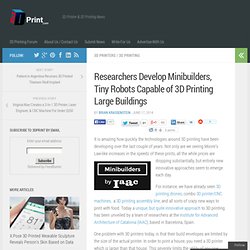
Not only are we seeing Moore’s Law-like increases in the speeds of these prints, all the while prices are dropping substantially, but entirely new innovative approaches seem to emerge each day. For instance, we have already seen 3D printing drones, combo 3D printer/CNC machines, a 3D printing assembly line, and all sorts of crazy new ways to print with food.
Today a unique, but quite innovative approach to 3D printing has been unveiled by a team of researchers at the Institute for Advanced Architecture of Catalonia (IAAC), based in Barcelona, Spain. One problem with 3D printers today, is that their build envelopes are limited by the size of the actual printer. “Within the construction industry we haven’t seen any disruptive technologies being introduced for almost a century,” stated the IAAC research team. The World’s First 3D-Printing Vending Machine. Transform 3D print into a high quality finished part with 3D Refiner. April 2, 2013 Cleaning 3D prints and improving the finish can be time consuming.
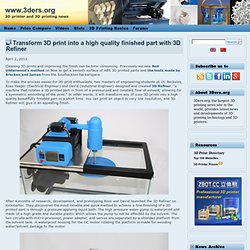
Previously we saw Neil Underwood's method on how to get a smooth surface of ABS 3D printed parts and the tests made by Bracken and James from the Southackton hackerspace. To make the process easier for 3D print enthusiasts, two masters of engineering students at UC Berkeley, Ross Yeager (Electrical Engineer) and David (Industrial Engineer) designed and created 3D Refiner, "a machine that rotates a 3D printed part in from of a pressurized and constant flow of solvent, allowing for a symmetric smoothing of the print.
" In other words, it will transform any of your 3D prints into a high quality beautifully finished part in a short time. You can print an object in very low resolution, and 3D Refiner will give it an appealing finish. After 4 months of research, development, and prototyping Ross and David launched the 3D Refiner on Kickstarter. Part Loaded and Ready to Refine. Price compare 3D printers. Current Projects - WobbleWorks LLC. Portable 3D Scanners for 3D Scanning. Ecco a voi… la mini i3. Chi non ha ancora una... - MakerBlog.
Ecco a voi… la mini i3.

Chi non ha ancora una stampante ti chiede: “ma è possibile farne una più grande?” E tu spieghi che se per stampare un oggetto impieghi tre giorni di fila, e magari va via la corrente o finisci la bobina di filamento, hai sprecato tre giorni. Meglio piuttosto dividere l’oggetto in parti più piccole da assemblare -e il volume di stampa di una Prusa i3, 20x20x20cm, non è comunque poco- o da stampare in parallelo su più macchine.
Io mi sono divertito a progettare una stampante portatile: la mini i3, il cui volume di stampa è pari a 10x10x10cm. Si aggiunge alle portatili esistenti: la Huxley, la Tantillus, la FoldaRap. Creaform’s Latest Go!SCAN 3D Handheld Scanner. 3D technology is in rapid expansion mode these days in its all forms. One such area with tremendous growth potential and appeal to a wider audience is portable 3D scanners, which provide a means of generating 3D digital data that can be converted into a 3D model and subsequently 3D printed. Scanning is a significant tool for reverse engineering or product development projects and the ability to control the scanner with handheld versions is an asset for many applications, however, like 3D printing the equipment is often cost prohibitive.
The advent of affordable 3D printers has contributed significantly to the market for affordable 3D scanners increasing dramatically. The Canadian company Creaform, has responded to this challenge and has introduced the Go!
Open source filament maker. Plans now available for the Filabot Wee You might remember Tyler McNaney’s Filabot, the personal filament maker, we featured earlier in the year that about his Kickstarter campaign to raise money for development costs.
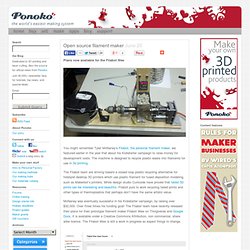
Desktop Laser Sintering by Shapeways. 3D hand scanner. The different technologies behind 3D Printing. What we call “3D Printing” includes different fabrication methods.
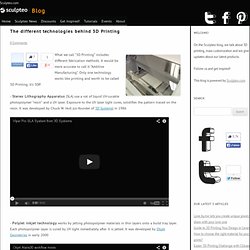
It would be more accurate to call it “Additive Manufacturing”. Only one technology works like printing and worth to be called 3D Printing: it’s 3DP. - Stereo Lithography Apparatus (SLA) use a vat of liquid UV-curable photopolymer “resin” and a UV laser. Exposure to the UV laser light cures, solidifies the pattern traced on the resin. It was developed by Chuck W. . - PolyJet inkjet technology works by jetting photopolymer materials in thin layers onto a build tray layer.
. - Selective Laser Sintering (SLS) uses a high power laser to fuse small particles of plastic, metal (direct metal laser sintering), ceramic, or glass powders. The world’s first ‘printed’ aircraft (Southampton) Southampton engineers fly the world’s first ‘printed’ aircraft Ref: 11/75 28 July 2011 SULSA is the world’s first ‘printed’ aircraft.
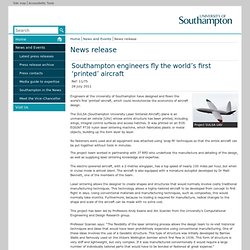
Engineers at the University of Southampton have designed and flown the world’s first ‘printed’ aircraft, which could revolutionise the economics of aircraft design. The SULSA (Southampton University Laser Sintered Aircraft) plane is an unmanned air vehicle (UAV) whose entire structure has been printed, including wings, integral control surfaces and access hatches. No fasteners were used and all equipment was attached using ‘snap fit’ techniques so that the entire aircraft can be put together without tools in minutes. The project team worked in partnership with 3T RPD who undertook the manufacture and detailing of the design, as well as supplying laser sintering knowledge and expertise. The electric-powered aircraft, with a 2-metres wingspan, has a top speed of nearly 100 miles per hour, but when in cruise mode is almost silent. Printable Solar Cells (MIT)